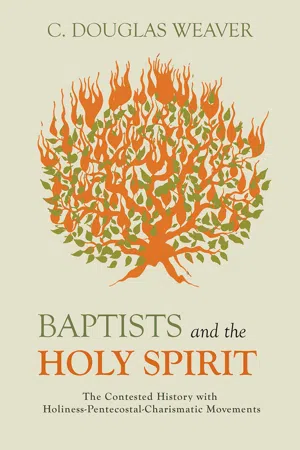1 Frederick Dale Bruner and William Hordern, The Holy Spirit: Shy Member of the Trinity (Minneapolis: Augsburg, 1984).
2 David Edwin Harrell, Jr., All Things Are Possible: The Healing and Charismatic Revivals in America (Bloomington: Indiana University Press, 1975).
3 C. Douglas Weaver, The Healer-Prophet, William Marrion Branham: A Study of the Prophetic in American Pentecostalism (Macon, Ga.: Mercer University Press, 1987).
4 Timothy Smith noted some Baptist involvement in the Holiness Movement. Timothy Smith, Revivalism and Social Reform: American Protestantism on the Eve of the Civil War (Gloucester, Mass.: Peter Smith, 1976). Gerald King’s work on pentecostal responses to fundamentalism helpfully included the stories of several Baptist fundamentalists. Gerald King, Disfellowshiped: Pentecostal Responses to Fundamentalism in the United States, 1906-1943 (Eugene, Ore.: Pickwick, 2011). In his various writings on the charismatic movement, pentecostal historian Vinson Synan has noted the number of Baptists in the charismatic movement and identified some key figures in the narrative. For example, see Vinson Synan, “Baptists Ride the Third Wave,” Charisma, December 1986, 52–55.
5 My survey of Baptist history in the United States highlights the theme of restorationism. See C. Douglas Weaver, In Search of the New Testament Church: The Baptist Story (Macon, Ga.: Mercer University Press, 2008). For other studies on restorationism, see Richard T. Hughes and Leonard Allen, Illusions of Innocence: Protestant Primitivism in America, 1630-1875 (Chicago: University of Chicago Press, 1988); Richard T. Hughes, The American Quest for the Primitive Church (Urbana: University of Illinois Press, 1988); Richard T. Hughes, The Primitive Church in the Modern World (Urbana: University of Illinois Press, 1995); and Steven L. Ware, Restorationism in The Holiness Movement in the Late Nineteenth and Early Twentieth Centuries (Lewiston, N.Y.: Edwin Mellen, 2005).
6 C. Douglas Weaver, “Baptists and Spirit-Led Experience,” Baptist History and Heritage 51, no. 2 (Summer 2016): 4–22; C. Douglas Weaver, “Restoring the New Testament Church? Baptist Self-Perception(s) in America from the Mid-Nineteenth to Early Twentieth Centuries,” in Mirrors and Microscopes: Historical Perceptions of Baptists, papers from the International Conference on Baptist Studies VI, ed. C. Douglas Weaver (Milton Keynes, UK: Paternoster Press, 2015), 129–48.
7 Ron M. Phillips, Awakened by the Spirit (Nashville: Thomas Nelson, 1999), 97–98, quoting John Broadus, Sermons and Addresses (Baltimore: R. H. Woodward, 1890), 228–30. Colonial Baptist chronicler Morgan Edwards said the preaching style of Stearns and his followers produced “outcries, epilepsies and extacies [sic].” Morgan Edwards, quoted in Elder John Sparks, The Life and Legacy of Elder Shubal Stearns: The Roots of Appalachian Christianity (Lexington: University Press of Kentucky, 2001), 69.
8 Thomas R. McKibbens, Jr. and Kenneth L. Smith, The Life and Works of Morgan Edwards (New York: Arno, 1980), 84–90.
9 P. H. Alexander, “Slain in the Spirit,” in Dictionary of Pentecostal and Charismatic Movements, ed. Stanley M. Burgess and Gary B. McGee (Grand Rapids: Regency Reference Library/Zondervan, 1988), 788–89; Vinson Synan, “Pentecostal Revivals,” in Encyclopedia of Religious Revivals in America, vol. 1, A–Z, ed. Michael McClymond (Westport, Conn.: Greenwood, 2007), 325.
10 William L. Lumpkin, Baptist Confessions of Faith (Valley Forge, Pa.: Judson, 1969), 351. Vinson Synan sees this as positive evidence for a charismatic use of spiritual gifts. Synan, “Baptists Ride the Third Wave,” 52.
11 Lumpkin, Baptist Confessions of Faith, 281.
12 A. D. Gillette, ed., Minutes of the Philadelphia Baptist Association, 1707 to 1807, tricentennial ed. (Springfield, Mo.: Particular Baptist Press, 2007), 372–76.
13 Martin Marty, “Baptistification Takes Over,” Christianity Today, September 2, 1983, 33–36.
Chapter 1: Baptists and the Holiness Movement
1 Some of the material in this chapter was first used in C. Douglas Weaver, “Baptists and Holiness in the Nineteenth Century: A Story Rarely Told,” Wesleyan Theological Journal 49, no. 1 (Spring 2014): 156–74. Used by permission.
2 Wesley thought of holiness in Christocentric terms: “having the mind of Christ in you” (Phil 2:5).
3 Melvin Dieter, The Holiness Revival of the Nineteenth Century, 2nd ed. (Lanham, Md.: Scarecrow, 1996), 2.
4 For more on the shift to pentecostal imagery, see Donald Dayton, Theological Roots of Pentecostalism (Grand Rapids: Francis Asbury, 1987), 71–79, 90.
5 Dieter, Holiness Revival of the Nineteenth Century, 18. See also Dayton, Theological Roots of Pentecostalism, 66.
6 Dayton, Theological Roots of Pentecostalism, 66–67, 77.
7 Donald Dayton makes this point about the hope of power for “powerless” participants in the Holiness Movement. Dayton, Theological Roo...
